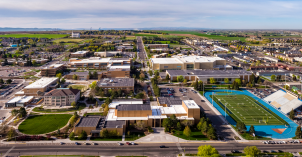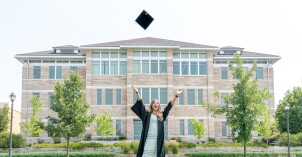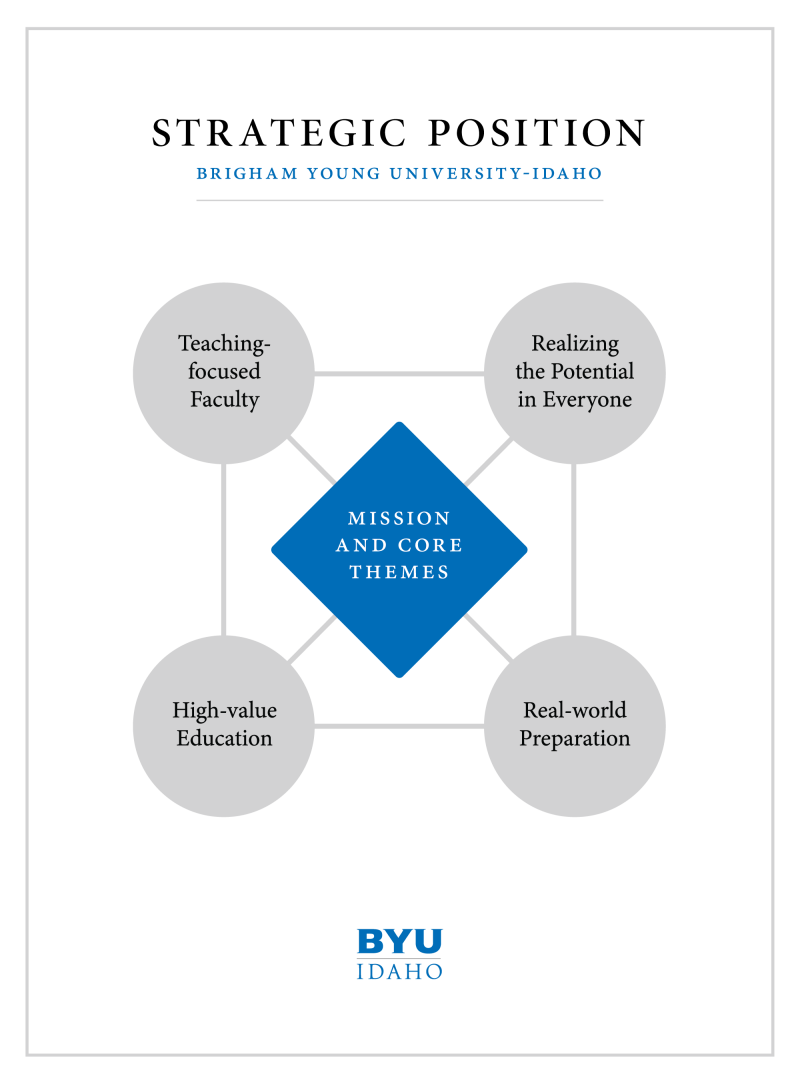The BYU-Idaho Strategic Plan
Brigham Young University-Idaho (BYU-Idaho or the university) is a private four-year university owned and operated by The Church of Jesus Christ of Latter-day Saints (the Church). The institution’s 430-acre campus (of which 255 acres are developed) is located in Rexburg, Idaho. Rexburg is an agricultural community in the heart of the Upper Snake River Valley.
Transition from a Two-year to a Four-year Institution
Until June 2000, the institution operated as Ricks College, a two-year junior college. It was originally accredited by the Northwest Association of Schools and Colleges in 1936. On June 21, 2000, the Ricks College Board of Trustees directed Ricks College to transition from a two-year junior college to a four-year baccalaureate institution. Accreditation was reaffirmed for Ricks College in 1999. On September 1, 2003, the Northwest Commission on Colleges and Universities (NWCCU) granted accreditation at the baccalaureate level to BYU-Idaho.
BYU-Idaho's Origins
Jacob Spori, a highly educated Swiss immigrant, was appointed the first principal of Bannock Stake Academy in 1888. He served as its principal until 1891.
The academy struggled to survive during its early years. Principal Spori's example of selflessness guides the university today. When the academy was once strapped for money, he offered his salary toward the debt of the school. He also worked on the railroad for a time, using some of his earnings to help pay the salaries of other teachers.
The following quote, often attributed to Principal Spori, is a pillar tenet for the university's growth:
The seeds we're planting today will grow and become mighty oaks and their branches will run all over the earth.

Building upon the foundation set by Jacob Spori, later presidents led the school during trying financial times. They amplified its religious mission to align with Church leadership.
President Henry B. Eyring said in a talk entitled “A Steady, Upward Course”:
[Heavenly Father] knows you. He has known you and has nurtured you. He has a plan for you as He has a plan for this institution of what it might become if it can just have revealed, both to the institution and to you, who you really are. Oh, He loves you! He knows you. He smiles down upon you. I so testify.

BYU-Idaho's Mission is Central to its Purpose
The BYU-Idaho mission and core themes remain the central purpose of BYU-Idaho. Even though higher education in the United States has greatly changed over the past 100 years, BYU-Idaho’s mission and core themes have served the institution well. (The Board made some minor updates to the mission and core themes in 2015 and 2017).
The mission and core themes of BYU-Idaho are widely understood by faculty, students, and employees. They are focal points that guide administrative decision-making and prioritizing efforts.
BYU-Idaho Mission & Core Themes
Brigham Young University-Idaho was founded by The Church of Jesus Christ of Latter-day Saints. The Church supports and guides BYU-Idaho's mission to develop disciples of Jesus Christ who are leaders in their homes, the Church, and their communities.
The university does this by:
- Building testimonies of the restored gospel of Jesus Christ and fostering its principles in a wholesome academic, cultural, and social environment
- Providing a high-quality education that prepares students of diverse interests and abilities for lifelong learning and employment
- Serving as many students as possible within resource constraints
- Delivering education that is affordable for students and the Church
Strategic Position

In 2000, when President Gordon B. Hinckley announced the transformation of Ricks College from a two-year junior college to Brigham Young University-Idaho, a four-year institution, he said the school would “have a unique role in and be distinctive from the other institutions of higher education within the Church Educational System.”
How BYU-Idaho Rethinks Education
BYU-Idaho’s strategic position was created by making choices and trade-offs of what the university will and will not engage in. This results in a specific and sometimes different set of activities.
BYU-Idaho’s distinctive characteristics are set forth in its strategic position. Its position relies primarily on inspired statements from its Foundational Addresses that the Lord has a plan for BYU-Idaho.
As Clark G. Gilbert, Commissioner of the Church Educational System, explained, BYU-Idaho’s mission is similar to other CES schools in that they all have a “unifying purpose and mission to develop disciples of Jesus Christ who can be leaders in the Church, in their homes, and in their workplaces.” However, recognizing that each institution in Church education has its own unique role, Commissioner Gilbert referred to BYU-Idaho as “the teacher.”
BYU-Idaho as the Teacher
BYU-Idaho is distinctive in the world of higher education because it is student-focused by design. That means the university puts student success at the heart of all it does. The fruit of this focus is found in what students accomplish because of BYU-Idaho’s strategic position.
While centered around the mission of building disciples of Jesus Christ who are leaders in their homes, the Church, and their communities, BYU-Idaho was distinctively designed with the following points of emphasis:
Quotes From Foundational Addresses That Define the BYU-Idaho Strategic Position
To stay centered on the mission, “every innovation, every change, will be measured against this test of the heart. How would this proposed change build testimony and true conversion to the restored gospel of Jesus Christ in the heart of a student?” (Henry B. Eyring, “A Steady, Upward Course,” BYU-Idaho Foundational Addresses, September 18, 2001).
“Developing and deepening our devotion as disciples of the Lord Jesus Christ” is our top priority (David A. Bednar, “BYU-Idaho: A Disciple Preparation Center,” BYU-Idaho Foundational Addresses, August 31, 2004).
“In this school of Zion in Rexburg…disciples can follow the Savior and learn of and from Him the lessons that will prepare them for effective service in their home, in the Church, and in their communities and careers” (David A. Bednar, “BYU-Idaho: A Disciple Preparation Center,” BYU-Idaho Foundational Addresses, August 31, 2004).
In addition to the mission-focused test, good strategy requires trade-offs in choosing what to do and what not to do—it involves finding the right fit. Thus, every policy, program, or initiative that is proposed needs to also fit with BYU-Idaho’s distinctive strategic position—its unique role within CES.
The following statements from the Foundational Addresses define the unique and distinct strategic position of BYU-Idaho:
Teaching-Focused Faculty
- “BYU-Idaho will continue to be teaching oriented” (Gordon B. Hinckley, “Announcement: Ricks College to Become BYU-Idaho,” BYU-Idaho Foundational Addresses, June 21, 2000).
- “Bring…teachers who have the Savior and His goal in their hearts” (Henry B. Eyring, “A Steady, Upward Course,” BYU-Idaho Foundational Addresses, September 18, 2001).
- “Effective teaching and advising will be the primary responsibilities of [BYU-Idaho’s] faculty, who are committed to academic excellence” (Gordon B. Hinckley, “Announcement: Ricks College to Become BYU-Idaho,” BYU-Idaho Foundational Addresses, June 21, 2000).
- “Faculty rank will not be a part of the academic structure of [BYU-Idaho]” (Gordon B. Hinckley, “Announcement: Ricks College to Become BYU-Idaho,” BYU-Idaho Foundational Addresses, June 21, 2000).
- “[BYU-Idaho] will be just as good a teaching institution as we can make it.”
- “The phrase ‘rethinking education’ is not to be only a slogan for the transformation from a two- to four-year status, the school is to be a place of educational innovation—permanently” (Henry B. Eyring, “A Steady, Upward Course,” BYU-Idaho Foundational Addresses, September 18, 2001).
- “We should be excellent scholars, and our scholarship should be focused on the processes of learning and teaching” (Henry B. Eyring, “A Steady, Upward Course,” BYU-Idaho Foundational Addresses, September 18, 2001).
- "We will not be a recognized and highly regarded research institution in the traditional sense of the term” (Henry B. Eyring, “A Steady, Upward Course,” BYU-Idaho Foundational Addresses, September 18, 2001).
- "I see the scholarship of learning and teaching at BYU-Idaho increasingly reaching a wider community of practice” (Clark G. Gilbert, "Inaugural Response from President Clark G. Gilbert," BYU-Idaho Foundational Addresses, September 15, 2015).
- “One of the hallmarks of BYU-Idaho is the personal investment of faculty who unapologetically build their professional focus on teaching and advising students” (Clark G. Gilbert, "Inaugural Response from President Clark G. Gilbert," BYU-Idaho Foundational Addresses, September 15, 2015).
Realizing the Potential in Everyone
- “We will see the potential in others as He sees it” (Henry B. Eyring, “A Steady, Upward Course,” BYU-Idaho Foundational Addresses, September 18, 2001).
- “BYU-Idaho will phase out its involvement in intercollegiate athletics and shift its emphasis to a year-round activity program designed to involve and meet the needs of a diverse student body” (Gordon B. Hinckley, “Announcement: Ricks College to Become BYU-Idaho,” BYU-Idaho Foundational Addresses, June 21, 2000).
- “[BYU-Idaho] will be assessing and restructuring its academic offerings” (Gordon B. Hinckley, “Announcement: Ricks College to Become BYU-Idaho,” BYU-Idaho Foundational Addresses, June 21, 2000).
- "We will see the greatest work of our lives as nurturing others as the Savior did. We will see the potential in others as He sees it” (Henry B. Eyring, “A Steady, Upward Course,” BYU-Idaho Foundational Addresses, September 18, 2001).
- “Our obligation is to…find ways for this college to serve young people whose needs are shaped by a great variety of cultures and situations, and who may not be able to come to this campus" (Henry J. Eyring, "Inaugural Response from President Henry J. Eyring," BYU-Idaho Foundational Addresses, September 19, 2017).
- “In [President Henry B. Eyring’s] inaugural address, he referenced ‘a long tradition of open admissions’”—BYU-Idaho currently admits about 97% of applicants (Henry J. Eyring, "Inaugural Response from President Henry J. Eyring," BYU-Idaho Foundational Addresses, September 19, 2017).
- “President Gilbert emphasized our responsibility to serve ‘everyday students’ and to eschew academic traditions that would distract us from them” (Henry J. Eyring, "Inaugural Response from President Henry J. Eyring," BYU-Idaho Foundational Addresses, September 19, 2017).
- “A particular hallmark of this institution has been an anxious concern for students who doubt their place here. But now our student body growth, along with the more complex and rigorous curricular offerings of a four-year institution, compounds the challenge of ministering one-by-one. Providentially, we have been blessed with innovative approaches to helping all students…[and] we are reminded of the unique learning needs of college students who may be at risk” (Henry J. Eyring, "Inaugural Response from President Henry J. Eyring," BYU-Idaho Foundational Addresses, September 19, 2017).
High-Value Education (Formerly the Three Imperatives—Quality, Reach, and Cost)
- “[BYU-Idaho] will emphasize undergraduate education and will award baccalaureate degrees; graduate degrees will not be offered” (Gordon B. Hinckley, “Announcement: Ricks College to Become BYU-Idaho,” BYU-Idaho Foundational Addresses, June 21, 2000).
- "It will be necessary for us at [BYU-Idaho] to serve ever better the thousands of students we have on campus while simultaneously reaching out to bless the lives of tens of thousands of young Latter-day Saints throughout the world” (David A. Bednar, "Inaugural Response from President David A. Bednar," BYU-Idaho Foundational Addresses, February 27, 1998).
- “BYU-Idaho will operate on an expanded year-round basis, incorporating innovative calendaring and scheduling while also taking advantage of advancements in technology which will enable the four-year institution to serve more students” (Gordon B. Hinckley, “Announcement: Ricks College to Become BYU-Idaho,” BYU-Idaho Foundational Addresses, June 21, 2000).
- “Predictably, the school will need to change and eliminate some long-standing and beneficial programs as the school focuses upon key academic disciplines and activities” (Gordon B. Hinckley, “Announcement: Ricks College to Become BYU-Idaho,” BYU-Idaho Foundational Addresses, June 21, 2000).
- “There would be a focus, not a growth and spread, in the academic offerings” (Henry B. Eyring, “A Steady, Upward Course,” BYU-Idaho Foundational Addresses, September 18, 2001).
- “The expectation is clearly that inspired and frugal people will find ways to bless more students at ever lower cost per student” (Henry B. Eyring, “A Steady, Upward Course,” BYU-Idaho Foundational Addresses, September 18, 2001).
- “We must and will find ways to improve and to innovate that require little or no money” (Henry B. Eyring, “A Steady, Upward Course,” BYU-Idaho Foundational Addresses, September 18, 2001).
- “There is a responsibility to be prudent in the management of the resources” (Henry B. Eyring, “A Steady, Upward Course,” BYU-Idaho Foundational Addresses, September 18, 2001).
- “We must learn to assist and bless institute students and other [Latter-day Saint] youth in Rhode Island and Rome while effectively serving our students on campus in Rexburg” (David A. Bednar, "Inaugural Response from President David A. Bednar," BYU-Idaho Foundational Addresses, February 27, 1998).
- President Kim B. Clark called for three new imperatives: serving more students, at an affordable cost, while raising quality (Kim B. Clark, "Inaugural Response from President Kim B. Clark," BYU-Idaho Foundational Addresses, October 11, 2005).
- “If designed correctly, the innovations on campus and online will be mutually reinforcing” (Clark G. Gilbert, "Inaugural Response from President Clark G. Gilbert," BYU-Idaho Foundational Addresses, September 15, 2015).
- “I see a faculty creating innovative curriculum at the intersection of disciplinary depth and instructional excellence” (Clark G. Gilbert, "Inaugural Response from President Clark G. Gilbert," BYU-Idaho Foundational Addresses, September 15, 2015).
- “Since President Hinckley’s announcement, the number of students at BYU-Idaho has tripled even as the relative cost per student has declined—a miracle within the Church and a model for ‘rethinking education’ more generally” (Clark G. Gilbert, "Inaugural Response from President Clark G. Gilbert," BYU-Idaho Foundational Addresses, September 15, 2015).
- “BYU-Idaho’s founding design included an emphasis on applied learning.…Applied degrees that are not bachelor’s centric will benefit many of our students” (Clark G. Gilbert, "Inaugural Response from President Clark G. Gilbert," BYU-Idaho Foundational Addresses, September 15, 2015).
- “Our mission is different, and our curriculum design must be as well.…[For example,] the nesting of a certificate and an associate degree within the bachelor’s program” (Henry J. Eyring, "Inaugural Response from President Henry J. Eyring," BYU-Idaho Foundational Addresses, September 19, 2017).
- “When we prepare students for the world of work, they are also prepared for graduate education. However, the converse does not necessarily hold” (Henry J. Eyring, "Inaugural Response from President Henry J. Eyring," BYU-Idaho Foundational Addresses, September 19, 2017).
Real-World Preparation
- “[They] will become life-long teachers in their families, in the Church, and in their work” (Henry B. Eyring, “A Steady, Upward Course,” BYU-Idaho Foundational Addresses, September 18, 2001).
- “They will be natural leaders who know how to teach and how to learn” (Henry B. Eyring, “A Steady, Upward Course,” BYU-Idaho Foundational Addresses, September 18, 2001).
- “Those graduates of BYU-Idaho will become legendary for their capacity to build the people around them and to add value wherever they serve” (Henry B. Eyring, “A Steady, Upward Course,” BYU-Idaho Foundational Addresses, September 18, 2001).
- “If we are truly student-centered, we must also be able to strengthen student outcomes that include life skills, career stewardship, family life, and spiritual leadership” (Clark G. Gilbert, "Inaugural Response from President Clark G. Gilbert," BYU-Idaho Foundational Addresses, September 15, 2015).
- “President Kim B. Clark often summarized the mission of BYU-Idaho as developing disciple leaders. President Henry B. Eyring has said that ‘every innovation, every change, [should be] measured against this test of the heart.’ To build disciple leaders in the last days, we must help our students have the conviction to stand as witnesses of Jesus Christ” (Clark G. Gilbert, "Inaugural Response from President Clark G. Gilbert," BYU-Idaho Foundational Addresses, September 15, 2015).
- “Better than the most thorough risk analysis, though, is a bachelor’s degree that prepares graduates to be ‘natural leaders who know how to teach and how to learn’” (Henry J. Eyring, "Inaugural Response from President Henry J. Eyring," BYU-Idaho Foundational Addresses, September 19, 2017).
- “BYU-Idaho graduates…are valued because their practical training and leadership abilities set them apart from colleagues who are merely technically competent” (Henry J. Eyring, "Inaugural Response from President Henry J. Eyring," BYU-Idaho Foundational Addresses, September 19, 2017).
Institutional Priorities
Under the stewardship of the Executive Strategy and Planning Council, these institutional priorities are the guiding basis for discussions about institutional self-evaluation and ongoing improvement. These priorities create a unified understanding and voice for the future direction of the university.
BYU-Idaho’s institutional priorities describe specific action plans the university is focusing on to further its mission, core themes, and strategic position. They are as follows:
- Discipleship and Learning—Ground all major academic initiatives on the foundation of the BYU-Idaho mission.
- Student Honor—Focus on student honor and integrity and prepare for drifting values.
- Student Success and Retention—Focus on efforts that strengthen retention and perpetuate student success.
- Accreditation—Engage with accrediting bodies as necessary and with agencies regarding bylaws, policies, outcomes, and assessments.
- Curriculum Improvement—Focus on curricular improvement to help students keep pace with industry changes, develop skills to meet the needs of the marketplace, and implement Institutional Learning Outcomes to prepare students broadly for their futures.
- Learning, Innovation, and Collaboration—Foster a culture where faculty members actively engage in inspired inquiry, innovation, and collaboration to become a “light on a hill” in the scholarship of learning and teaching.
- Employment—Develop a model that unites university efforts, identifies shared responsibility, and increases the percentage of students who obtain meaningful employment or other career outcomes within 120 days of graduation.
- BYU-Pathway Relationship—Implement service agreements that enable BYU-Pathway Worldwide to serve students in BYU-Idaho-accredited online programs.
- Strategic Enrollment Management—Manage enrollments while considering Church demographic share and student behaviors, strengthen year-round school, and develop a concurrent enrollment program.
- BYU-Idaho Cost—Minimize the cost of BYU-Idaho in order to support quality education while serving as many students as possible.
The hope of university leadership is that by improving in these priority areas, the institution can move the needle on key metrics tied to the core themes. By doing so, they will guide continuous improvement toward fulfilling the mission and its effectiveness.
Priorities are continually worked on, with formal accountability reports submitted each quarter that include a review of the previous year and proposed efforts for the next year. The reports include data and write-ups from priority stewards.
Strategic Plan—Operation And Review
Mission & Core Themes
The mission and core themes explain the purpose of BYU-Idaho. The university reports its institutional efficacy internally and externally for two reasons:
Align Mission with Policies and Practices
First, as a religious institution, to continually align our stated beliefs with our policies and practices. BYU-Idaho prepares an executive summary for the Board each spring to describe their efforts around the mission and core themes. For 2022, BYU-Idaho reported the following:
- Discipleship: Devotionals, faculty hiring, the CES Honor Code, and gospel values in the classroom are among the key components of building disciples of Jesus Christ. Ninety-five (95%) percent of 2022 graduates reported that BYU-Idaho had a positive or sustaining impact on their faith in Jesus Christ and their testimony of living prophets and apostles.
- Leadership: The activities program, service in campus wards and stakes, the Learning Model, and student-employment opportunities are key elements of developing leaders. In 2022, 89% of students reported being involved in a leadership experience. Additionally, 82% of graduating students reported growth in leadership skills.
Clearly Define Mission Success and Improvement
Second, to define mission fulfillment and seek continuous improvement in two areas: student achievement and student learning.
In addition to being properly aligned and focused on its mission, BYU-Idaho defines mission fulfillment and institutional effectiveness by its success in meeting a set of selected key indicators contained in the Core Themes Report Cards. These report cards address typical questions that students and parents often ask about BYU-Idaho. They are reviewed regularly by the university’s leadership and reported externally to the NWCCU.
Strategic Position
The strategic position describes how BYU-Idaho is unique among institutions of higher education and within the Church Educational System. The strategy impacts every decision that is made at BYU-Idaho.
For 2022, BYU-Idaho reported the following to the Board for their efforts around the points of the Strategic Position:
- Teaching-focused Faculty: 98% of faculty completed annual interviews, and 90% have active annual plans focused on developing disciples and becoming effective teachers. In addition to their contractual responsibility, approximately 70% of all faculty engaged in Learning and Teaching events.
Realizing the Potential in Everyone: A study on high-risk students found that completion paths were not mathematically possible for many. As part of the analysis, adjusting three policies (retake, renewal, and at-risk classification) would create possible paths to completion without removing degree requirements. The policies were updated with scenario analysis indicating realistic opportunities for completion.
Additionally, the university engaged in outreach efforts to invite back students who had stopped out of school. BYU-Idaho monitors students as they move along new paths and respond to outreach efforts. Currently, the university admits 97% of those who apply.
- Real-world Preparation: Over 80% of academic programs include experiential learning requirements. In the last five years, students completed over 22,000 internships. BYU-Idaho currently offers 40 certificates, all designed with a focus on employable skills.
High-value Education: Over the last five years, the relative cost per full-time equivalent student (FTE) and cost of attendance remain low. In 2022, budget reallocations resulted in $2.5 million, which self-funded new and expanded programs.
Over 75% of students seeking employment received a job offer at graduation, and 90% of graduates received an employment offer 120 days after graduation. BYU-Idaho continues to closely associate with BYU-Pathway Worldwide to expand the reach of education across the Church.
Institutional Priorities
Institutional priorities are activities framed within the mission, core themes, and strategic position.
- Framing the priorities within the mission and core themes brings an understanding of why the university engages in those activities.
- Strategic position brings structure to how the university engages in its priorities.
Focusing on why and how the university engages in priorities is crucial to all efforts, planning, and decision-making.
BYU-Idaho's Strategic Planning
University leadership engaged in a future-back approach to the university’s strategic planning. The groups considered BYU-Idaho’s mission, core themes, strategy, and institutional objectives.
Additionally, the leadership councils discussed the principles taught in BYU-Idaho’s founding documents and reviewed the following:
- Distinctive characteristics of a BYU-Idaho education (Strategic Position)
- Three Imperatives: Quality, Cost, Reach
- Internal Growth Strategy Model
- Institutional Dashboard Data
- 2014 Gallup-Purdue Index Report: Great Jobs, Great Lives
- Anticipated conditions in the current job market
Based on those discussions, a set of institutional priorities was developed to guide BYU-Idaho through the next several years. BYU-Idaho administrators understood that those priorities would likely be adjusted over time as the university progresses forward, while still framing institutional priorities within the mission, core themes, and strategic position.



